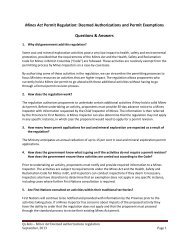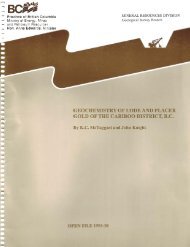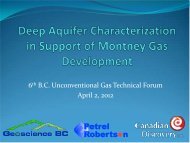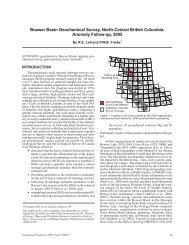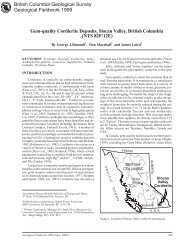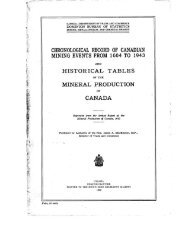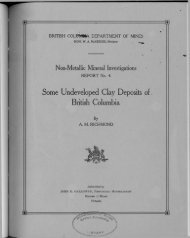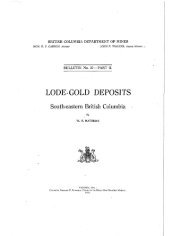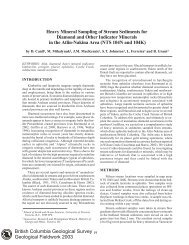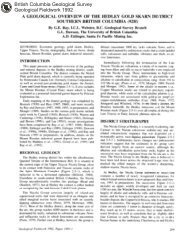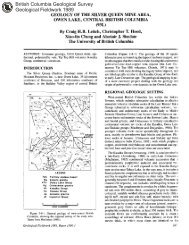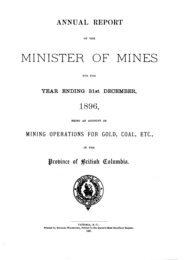PDF version - Ministry of Energy, Mines and Natural Gas
PDF version - Ministry of Energy, Mines and Natural Gas
PDF version - Ministry of Energy, Mines and Natural Gas
You also want an ePaper? Increase the reach of your titles
YUMPU automatically turns print PDFs into web optimized ePapers that Google loves.
Occurrence Identification<br />
Unknown Data entry is incomplete, or occurrence reported but nothing else known. **** Open circle 01 0<br />
3.6 REGION<br />
This field describes the part <strong>of</strong> the world the mineral occurrence is located in. For online coding it always defaults to<br />
"BC: British Columbia" but you must still click "Add" to select.<br />
3.7 LOCATION(*) (E01)<br />
Coordinates for an occurrence may be input in either a latitude-longitude or a Universal Transverse Mercator grid<br />
(UTM) format (North American Datum NAD 83 is the default). The MINFILE/pc <strong>and</strong> MINFILE/www online coding<br />
card will automatically convert whichever coordinates you enter to the alternate system. Geodetic (latitudelongitude)<br />
designations have an east to west convention while the UTM system has a west to east convention.<br />
It is much simpler to locate by UTM grid than by geodetic coordinates because the<br />
spacing is the same everywhere <strong>and</strong> is metric. There is some overlap <strong>of</strong> the<br />
coordinate system from zone to zone but for normal use the overlap is ignored.<br />
The location <strong>of</strong> an occurrence should be the most significant physical reference point. In some cases this will be an<br />
adit, portal or similar mine working. In other cases, the location may be defined as the centre <strong>of</strong> a mineral claim or<br />
group <strong>of</strong> claims, a point on the best exposure <strong>of</strong> a formation, etc. Commonly, the location is a trench, sample site,<br />
outcrop or drillhole site. This MUST be clearly stated in the Identification Comment Field, along with the reference<br />
from which the location was derived. For example: The Discovery trench at the southeast corner <strong>of</strong> the Sam claim<br />
(Assessment Report 99999). Locational data derived from engineering surveys should be used if available, but the<br />
data is usually from 1:50 000 scale or more detailed maps.<br />
3.7.1 LATITUDE/LONGITUDE: The latitude/longitude <strong>of</strong> a mineral occurrence is expressed<br />
in a degrees-minutes-seconds format. For example: Latitude 50 degrees 14 minutes 12<br />
seconds, Longitude 117 degrees 05 minutes 13 seconds. The range <strong>of</strong> possible values in<br />
British Columbia are: Latitude 48 degrees to 60 degrees, Longitude 114 degrees to 140<br />
degrees. Coordinates outside this range will be rejected by the system.<br />
3.7.2 UTM (UNIVERSAL TRANSVERSE MERCATOR) ZONE: The UTM system divides the<br />
world into 60 meridianal zones numbered 1 through 60, beginning at 180 degrees west.<br />
Each zone covers a strip 6 degrees wide in longitude. Zone numbers for the Northern <strong>and</strong><br />
Southern Hemispheres are indicated by positive or negative values respectively. Zone<br />
numbering starts at zone 1 from 180 degrees west to 174 degrees west <strong>and</strong> increases<br />
eastward to zone 60 between 174 degrees east to 180 degrees east.<br />
ZONE LOCATION<br />
file:///C|/HardcopyManual/04_codeocc.htm (4 <strong>of</strong> 7)2007-09-20 4:09:03 PM<br />
07 144 to 138 degrees west Longitude<br />
08 138 to 132 degrees west Longitude<br />
09 132 to 126 degrees west Longitude<br />
10 126 to 120 degrees west Longitude<br />
11 120 to 114 degrees west Longitude



